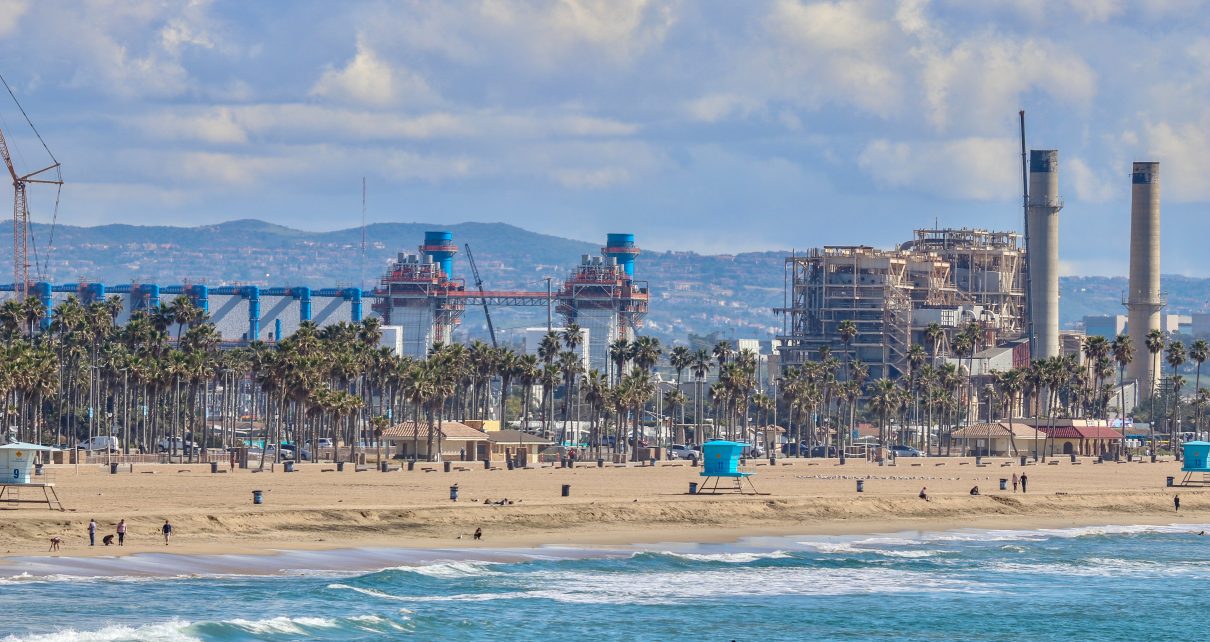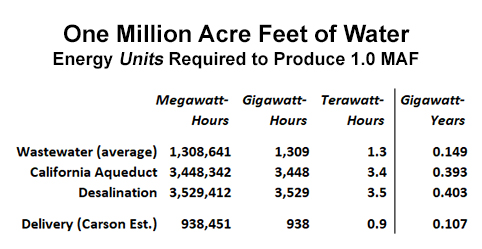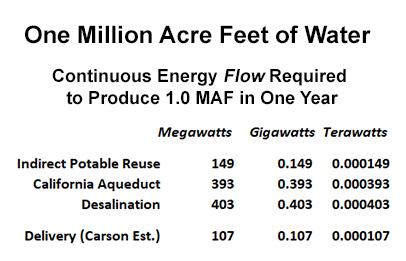
Southern California Desalination plant. (Photo: Shutterstock, KK Stock)
The Abundance Choice, Part 11: The Desalination Option
If you’re trying to eliminate water scarcity, desalination is an option you can’t ignore
By Edward Ring, June 5, 2022 2:30 am
On May 12, the California Coastal Commission Board of Directors voted 11-0 to deny the application from Poseidon Water to build a desalination plant in Huntington Beach. Since 1998, Poseidon has spent over $100 million on design and permit work for this plant. At least half of that money was spent on seemingly endless studies and redesigns as the Coastal Commission and other agencies continued to change the requirements. Poseidon’s denial makes it very unlikely another construction contractor will ever attempt to build a large scale desalination plant on the California coast.
This is a historic mistake. If you’re trying to eliminate water scarcity, desalination is an option you can’t ignore. Desalination has the unique virtue of relying on a literally inexhaustible feedstock, the world’s vast and salty oceans. At an estimated total volume of 1.1 quadrillion acre feet (1.1 billion million acre feet), there will always be enough ocean.
A balanced appraisal of desalination would acknowledge its potential while also recognizing the absurdity of suggesting it is a panacea. On one hand, desalination can be an indispensable solution to water scarcity. In Israel, for example, five massive desalination plants on the shores of the Mediterranean Sea produce nearly a half-million acre feet of fresh water per year, an amount the nation plans to double by 2030. Israel’s Sorek Desalination Plant, located a few miles south of Tel Aviv, produces 185,000 acre feet of fresh water per year, from a highly automated operation that only occupies about 25 acres. Up to 80 percent of Israel’s municipal water comes from desalination. Thanks to desalination, this nation of nine million people has achieved water abundance and is exporting its surplus water to Jordan.
On the other hand, just as renewable energy only provides a small fraction of the global energy supply, desalination only constitutes a small fraction of global water supply. Altogether, not quite 20,000 desalination plants worldwide produce less than 50 million acre feet of water per year. That’s an awful lot of water, but it’s less than one percent of global water consumption. To make a dent in the estimated 7,500 million acre feet per year of worldwide water consumption, desalination capacity would have to increase by an order of magnitude, to 500 million acre feet per year. In turn, that achievement would require about 200 gigawatts of continuous power, equivalent to the full output of 100 Hoover Dams.
The Energy Cost of Desalination is Not Prohibitive
Then again, as we will see, and for a variety of reasons, the frequently heard assertion that there isn’t enough energy available to spare any more of it for desalination is not true. For starters, 200 gigawatt-years is only 5.98 quadrillion BTUs, and worldwide, total energy production in 2020 was estimated at 528 quadrillion BTUs (or 17,653 gigawatt-years, or 557 exajoules, which is currently the authoritative BP Statistical Review of Global Energy’s energy mega-unit of choice). Therefore, to desalinate 500 million acre feet of water per year would only consume 1.1 percent of current global energy production.
Taking all of this into account, it’s fair to say that desalination is clearly part of the solution to water scarcity. The potential for a perpetual input of water from desalination plants to tilt the demand and supply equilibrium from one of scarcity to one of abundance should not be underestimated. Israel’s experience is proof of that.
Here in California, the energy required to desalinate seawater is considered one of the prohibitive obstacles towards wider adoption of the technology. But when the alternative to desalinating seawater is paying the energy cost of pumping it from the Sacramento Delta through nearly 300 miles of aqueducts, then lifting it over the Tehachapi pass, the energy costs become less daunting.
The following two charts illustrate the amount of energy necessary to deliver water to Southern California’s coastal cities from three differing sources: upgraded local wastewater treatment to indirect potable standards, interbasin transfer via the California Aqueduct, and desalination. Both charts examine the energy required to deliver 1.0 million acre feet of water. The first chart shows how many units of electrical energy are required, the second chart shows how much flow of electricity a power plant would have to generate in order for each system, operating continuously, to deliver one million acre feet in one year.
The first chart clearly shows that processing wastewater for indirect potable reuse is far more energy efficient than the alternatives. These figures are based on the average, taking into account the power requirements of two treatment plants, the Orange County’s Groundwater Replenishment System (GWRS), along with the wastewater recycling plant which is proposed to be built in the City of Carson in the Los Angeles Basin. According to engineers at GWRS, the plant draws 13 megawatts to treat 103,000 acre feet per year. Information provided by Met on the Carson plant’s design estimated a 30 megawatt draw to treat 168,000 acre feet per year. Based on the average of these two figures, these plants would require 1,309 gigawatt-hours to produce one million acre feet of water.
By comparison, the figures for desalination are based on the Carlsbad plant which draws 23 megawatts to produce 55,000 acre feet of water per year – not including power to deliver the desalinated water. That equates to 3,529 gigawatt-hours to produce one million acre feet of desalinated seawater.
As described earlier, the figures for the California Aqueduct were calculated based on adding up the power consumption per unit of water lifted for each of the six pumping stations that start with the Banks pumping plant just south of the Sacramento Delta, and terminate with the Edmonston pumping plant at the base of the Tehachapi Mountains. This titanic transfer of water has an energy cost of 3,448 gigawatt-hours per million acre feet of water delivered, only slightly better than desalination.
Because every urban setting will have unique requirements for a reuse or desalination project, based on the scale, and the location and elevation of the existing wastewater treatment plant and delivery destinations, it is impossible to generalize with respect to the delivery energy required. But the estimated energy necessary to pump water from the proposed Carson wastewater treatment plant in Los Angeles through up to 60 miles of pipelines to recharge several remote aquifers probably represents the higher amount any project is likely to need. As can be seen in the final row of data below, it is significant. Based on the best estimates made available, the energy necessary to distribute a unit of water from the Carson treatment plant to its destination adds 60 percent to the total energy requirement. This is nonetheless far more efficient than the energy needed to deliver water to Los Angeles via the California Aqueduct.
Making Units of Energy Intelligible
Because units of energy and water are often communicated to the public merely to serve as nuggets of credibility, with no attempt to put them in context or even explain them, four columns appear in the above chart. Each of these units is expressing the same amount of energy. One thousand megawatt-hours (column one) is equal to one gigawatt-hour (column two), and one thousand gigawatt-hours is equal to one terawatt-hour (column three). The fourth column also depicts the same amount of energy as reported in the first three columns, but expresses it in gigawatt-years. As discussed in previous installments, using gigawatt-years (or megawatt-years) is a good way of intuitively and immediately being able to estimate the yield of a renewable energy installation, or the up-time of a power plant, or the through-put of a hydroelectric dam, and so on.
By comparing the megawatt or gigawatt “nameplate capacity” of any project that generates or consumes electricity to that same project’s actual gigawatt-year output or consumption per year, you know the efficiency of that project without having to get out a calculator. As it is, column four – gigawatt-years – is simply the number of gigawatt-hours (column two) divided by the number of hours in a year (365.25 x 24).
In this case, gigawatt-years offers an additional intuitive benefit. It makes it easy to immediately get an idea of how much of California’s total power generation would be absorbed by one of these projects delivering 1.0 million acre feet per year. For example, in 2018, California consumed 57 gigawatt-year units of electricity, which means that on average, the energy flow through California’s energy grid was 57 gigawatts to consumers throughout the state. Therefore, desalinating 1.0 million acre feet of seawater, as can be seen, would consume not quite one percent of the total electricity currently being generated in California (.403 / 57). On the other hand, most of that electricity would be offset, because the California Aqueduct would not be required to pump that 1.0 million acre feet over the mountains if that water was being desalinated locally. Then again, unlike water from the California Aqueduct that flows downhill from the top of the Tehachapi pass and gathers sufficient pressure to gravity feed every distribution extremity in its entire network, desalinated water, like treated wastewater, has to be pumped to its destination, requiring additional energy.
The next chart, below, shows what size power plant would be required to produce 1.0 million acre feet per year based on each method. This chart, which reports flows of energy, assumes continuous operation for one year to deliver the 1.0 million acre feet. A power plant twice as big could deliver 1.0 million acre feet in six months, or 2.0 million acre feet in one year, and so on.
It should be emphasized that if the reader is not familiar with the distinction between units of electrical energy and flow of electrical energy, they are urged to spend some time with this. Given the simplicity of these concepts, engineers may laugh at such unwarranted pedantry. But surprisingly few journalists, politicians, political staffers, or zealous activists are sufficiently versed in these basics, much less conversant enough in them to be familiar not only with the nature of the variables, but their actual values with respect to critical infrastructure. How can anyone evaluate policy options, or even opine with any credibility, without at least trying to see the numerate big picture? For that matter, if it comes as a surprise that desalination only consumes slightly more energy than moving an equivalent amount of water through the California aqueduct, get ready for more surprises. Advances in desalination technology are moving fast.
Addressing Other Concerns About Desalination
Ultimately, the energy cost for desalination means it cannot easily compete with wastewater reuse which requires only about half as much energy per unit of output. But the inexhaustible feedstock, the imperative to have diverse sources of water in the event of supply disruption, and fact that at some point breakthrough technologies will dramatically lower the cost of energy, all make desalination an option that ought to be part of California’s portfolio of water supply projects.
While the energy cost is one major objection to desalination, there is also concern over how the intake pipes and brine disposal pipes affect aquatic life. The debate over the proposed Huntington Beach desalination plant, which would have been a twin to the recently constructed Carlsbad desalination plant, has generated a lot of information to address these environmental concerns. In March, 2021, I interviewed Scott Maloni, a vice president at Poseidon Water, the company that was attempting to build the Huntington Beach Plant. Here are excerpts:
1 – Isn’t desalinated water is contaminated with boron, which is a by-product of the desalination process?
Ocean water has higher concentrations of boron but it is removed by the reverse osmosis process. Boron isn’t a public health and safety concern, but high concentrations of boron can affect the vitality of certain crops and ornamental flowers. Irvine Ranch Water District (IRWD) raised a concern 6 years ago that higher boron levels in desalinated water could affect their ability to operate recycling plants because the byproduct of their plants might exceed regulatory requirements. The Huntington Beach project’s reverse osmosis system is designed to get the boron down to 0.75-1.0 mg/l, which fully addresses IRWD’s concerns.
2 – The Orange County Water District has said they will just store the desalinated water in their aquifers. Won’t that contaminate them?
Desalinated water will not contaminate the groundwater basin. The Orange County Water District (OCWD) puts 100 million gallons of treated wastewater into the groundwater basin every day using the same treatment process that the Huntington Beach desalination plant will use, reverse osmosis. OCWD has not made a decision whether to deliver the desalinated water to cities and water agencies directly through the potable water pipeline system or to inject some or all of the desalinated water into the groundwater basin. The groundwater basin is simply a means of distribution. Putting desalinated water into the groundwater basis allows cities throughout Orange County to pump more groundwater and rely less on imported water.
3 – Won’t marine life will be harmed both by dead zones at the point of brine disposal and destruction of larvae and plankton from the open intake pipes?
The facility is required by state regulations to incorporate the best available and feasible seawater intake and discharge technologies to minimize the intake and mortality of all forms of marine life. The plant will have 1-MM wedgewire screens on the intake with a through screen velocity of less than 0.5 feet per second and a brine diffuser on the outfall. The Santa Ana Regional Water Quality Control Board permit published last month [February 2021] and scheduled for approval in April [2021] finds that the project with these technologies complies with all state marine life protection regulations. There will be no “dead zone” from the discharge. Salinity from the discharge will be 35.5 ppt [parts per thousand], 2 ppt above ambient salinity, at an average radius of 79 feet from the point of discharge. Finally, despite the fact that numerous state agencies have found the unavoidable entrainment of microscopic fish larvae to be insignificant, Poseidon must still mitigate for these impacts as a condition of the Regional Board permit. Poseidon will preserve, restore and create 112 acres of coastal habitat to offset these larval fish impacts including 4 projects in the Bolsa Chica wetlands and a 5th project in the form of a 41-acre artificial reef off the coast of Palos Verdes.
What ought to be obvious from Maloni’s answers is that there is no place on earth that will be more attentive to environmental concerns than California. For that reason alone, California should build more desalination plants, and build them right, in order to set an example to the world.
Something that Maloni didn’t mention was the potential of the California current to disburse brine, the saltier water that remains after fresh water is pushed through the filtration membranes. Not only is desalination brine released under pressure so it will more quickly disburse, but the California current ensures it will never concentrate in one area but will always be swept away. The California current sweeps a mind boggling 250 quadrillion gallons per day of ocean water past the west coast. The Huntington Beach desalination plant is designed to produce 50 million gallons per day of fresh water. The corresponding quantity of daily brine, around 55 million gallons, represents roughly one five-millionth of the water moved by natural current along the coast each day.
To better understand the significance of this fact, consider the studies done on the impact of brine on the Mediterranean Sea, where the equivalent of ten Huntington Beach desalination plants now operate. Compared to the California coast, there is almost no current in the Eastern Mediterranean. And yet these marine environments are not seriously compromised, and adjustments are being made continuously to ensure it stays that way. In fact, most studies concluded that there was more disruption to the marine environment from the movement of water caused by release of the brine under pressure, than by the chemistry of the brine itself. Those studies can be referenced here, here, and here.
It would be a mistake to overemphasize desalination technology. The fact that our initiative campaign included desalination among the categories of projects eligible for funding allowed our opponents to focus, disproportionately, on that specific provision. They used that to mobilize activists that have been fighting desalination for years, and to repeat all of their one-sided arguments against desalination, most of which are addressed here. But it was not a mistake to include desalination among the eligible projects in our initiative. If Californians are serious about solving the water crisis, and achieving a diversity of water sources as a hedge against disaster, they must include desalination. It might never contribute more than a small fraction of California’s total water supply, but it will be a perennial source of water, serving the arid and densely packed coastal cities in Southern California where water is imported from other regions at great cost.
In the meantime, with or without California’s involvement in desalination, the nations of the world are adopting this technology. As the Coastal Commission prevents construction of new desalination plants in California, the state loses yet an0ther way it might overcome water scarcity. But perhaps worse, California loses the opportunity to set an example of best practices to the world.
- Ringside: What is the Future of California’s Republican Party? - December 31, 2025
- Ringside: CA GOP Just Blew $46 Million for Nothing – Here’s How They Can Avoid Repeating That Mistake in 2026 - December 24, 2025
- Ringside: Will the Delta Pumps Operate at Capacity this Winter? - December 18, 2025







Most of the coastal commissioners are from San Fran – hat explains the dysfunction.
The other one is a Hollywood executive’s wife…witu ties to extremist environmental organizations…
You’re right – that explains it… We’re led by idiots in California, but this changes tomorrow…
Aren’t there constant shortages of resources in Communist countries? Yes. Aren’t the Democrats working to create the same situation in California? Yes.
That’s why the project was not approved by the California Coastal Commission, and is opposed by leftist groups masquerading as environmental groups.
Is the California Coastal Commission reallying trying to solve our water problem?
Given:
https://droughtmonitor.unl.edu/
California is not the only state that has this problem. According to the map, the western half of the United States has a water problem.
If Arizona can do this, why can’t California do the same?
https://www.jpost.com/business-and-innovation/energy-and-infrastructure/article-708201
What does it take to make this happen, more fires and plant, animal and human deaths?
Do they have a cognitive dissonance problem to California’s water problem? All you have to do a take few helicopter site surveys to our water dams and lakes to see we have a problem.
As with nuclear power plants, the spector of bloated, burecratic stupidity rears it’s ugly head to destroy any intelligent, common sense solution to a state wide problem, that the burecrats see as a threat to their power and control. Government stomping out any creative spark to further stagnation and societial collapse.